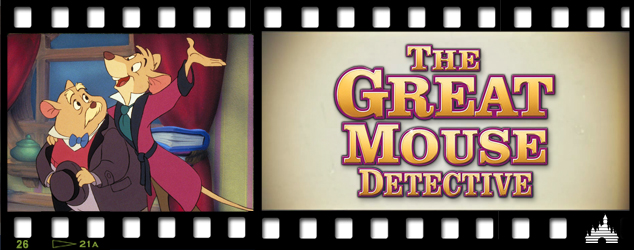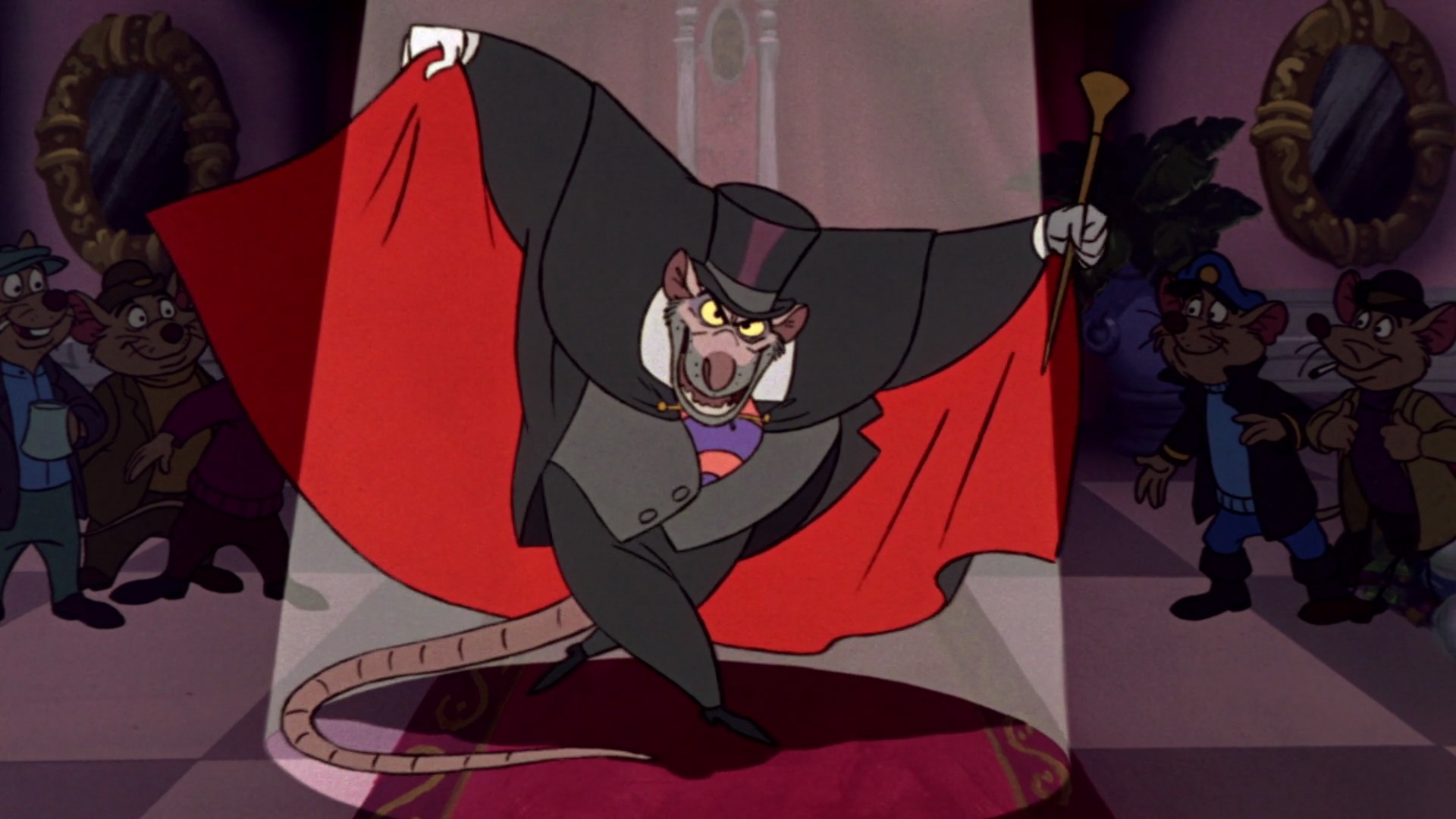
There are some movies that you love right away. Then, there are the ones that terrify you so badly that they warp you forever.
Okay, okay; maybe The Great Mouse Detective didn’t warp me, but it did scare the tar out of my childhood self. You see, I was quite sensitive to jump scares. I always reacted strongly to them, and I always came out of them feeling embarrassed. They’re the reason I didn’t see Twilight Zone: The Movie for one eight-year stretch, and they’re the reason I’ve never played Five Nights At Freddy’s (even though I like the concept behind the game, and the upcoming movie intrigues me).
What does this have to do with The Great Mouse Detective? Well, the movie happens to feature this character:

That’s Fidget. He’s fond of startling people.
The first scene—where Fidget leaps from an open window right into the face of the viewer, sharp teeth fully bared—was so terrifying to my young self that I ran from the room. As I recall, I didn’t finish the movie that day. I did return to the film later on, and I actually watched it many times during my childhood years. I always made sure to be out of the room during that opening scene, though.
I share that embarrassing story with you for two reasons. First, I thought it would be a fun way to draw you in. More importantly, however, the anecdote depicts what makes The Great Mouse Detective one of my favorite Disney Canon films. Disney Animation’s two prior movies, The Fox And The Hound and The Black Cauldron, were, respectively, a tear-jerking melodrama and a fantasy film with lots of dark imagery. The Great Mouse Detective marks a return to the humor that made films like The Jungle Book so much fun, while retaining a dark, scary edge. It’s a perfect blending of vibes!

The time: 1897. The place: the gas-lit streets of Victorian-era London. Little Olivia Flaversham (Susanne Pollatschek) is enjoying a quiet evening with her father, master toy-maker Hiram Flaversham (the great Alan Young) when Fidget (Candy Candido) bursts into the shop. Olivia hides in a cabinet while Fidget destroys the store, gets my kid-self to soil my pants, and carries Olivia’s father off.
Meanwhile, surgeon Dr. David Q. Dawson (Vic Bettin) is just returning to London after a military tour of duty in Afghanistan. Dawson finds Olivia, who has gotten lost, on her way to Baker Street. She’s looking to hire the famous detective Basil (Barrie Ingham) to find her missing father. Dawson escorts Olivia to Basil’s residence, where they meet the famous detective just as a case comes to a screeching halt. Basil’s despondent, but he perks up when he hears Olivia’s story. You see, Fidget happens to be the right-hand-man to Basil’s arch-nemesis, the notorious Professor Ratigan (Vincent Price, just as great as Alan Young).
Basil sees a golden opportunity to finally place his enemy behind bars. However, there are questions that need answering. Why would Ratigan kidnap a toy-maker? What is Ratigan plotting? Why is he such a self-hating rat? Throughout the rest of the film, Basil, Dawson, and Olivia strive to uncover Ratigan’s evil plans and to rescue Olivia’s dad!

The Great Mouse Detective boasts a lot of likable qualities. However, my favorite thing about the film has always been the strength of its story. I’m a fan of mysteries and an even bigger fan of thrillers, and The Great Mouse Detective features great storytelling in both genres. It’s obvious that the story crew (and Eve Titus, author of the Basil Of Baker Street novels) were well-versed in the Sherlock Holmes canon; the film gives Basil plenty of chances to indulge in Sherlockian deductions, and each deduction does a great job pushing the plot forward. The film also trusts the audience’s intelligence in that it doesn’t spell out the importance of each clue. Instead, the story allows us to put our brains to work, analyzing the clues and matching wits with Basil.
However, The Great Mouse Detective makes a daring move in that it solves the mystery in the middle of the film. At the midpoint, it becomes clear what Ratigan’s evil plot is, just why he needed Mr. Flaversham, and what his end-goal is. The film is able to pull off this trick because it has a whole other story and genre up its sleeve. Once the mystery is solved, the story smoothly switches gears, transforming from a mystery to a thriller without a hitch. Such rail changes are notoriously hard to pull off, but The Great Mouse Detective makes it look easy.

That brings us to the characters, and that means it’s finally time to talk about RATIGAN! Oh, what a fantastic villain he is! He’s the perfect embodiment of the “high-class villain”; the one who mixes a cultured, civilized facade with the evil personality underneath. Vincent Price gives the perfect performance to match that persona. His voice drips with a slimy veneer of upper-crust style, while his horror-movie legacy helps him drive home the vicious, evil side of the Professor.
Of course, his evil scheme (to replace the Queen of England with an unrealistic-looking robot) is a silly one, but hey, even “The World’s Greatest Criminal Mind” makes a slip sometimes!

The other characters are decent. Basil is a good rodent approximation of Sherlock Holmes, complete with most of the Sherlockian quirks and touches: the sharp eye for detail, the penchant for the violin, the social awkwardness, etc. (For some reason, Disney chose to omit Sherlock’s cocaine use. Go figure.) Barrie Ingham does a great job channeling Basil Rathbone’s famous depiction of Holmes.
Dawson doesn’t fare quite as well; he falls victim to the popular misconception that Watson was just a good-natured but none-too-bright companion to Holmes. (Actually, in the original Holmes stories, it’s easy to see that Watson was just as intelligent as Sherlock. He just had a different skill-set and personality.) However, Dawson does provide the warmth that The Great Mouse Detective needs, and Vic Bettin does solid voice work!
That brings us to the animation. The animators do a solid, craftsman-like job; nothing flashy, but it gets the job done. It’s a little sketchier than The Black Cauldron or The Fox And The Hound, but that’s understandable; after the financial fiasco that Cauldron was, it’s natural that the execs wanted costs down. Unfortunately, it does affect the quality of the artwork. One can’t ask for everything, though!

If any animator deserves special mention, it’s Glen Keane for his work on Ratigan. Just like on The Fox And The Hound, Keane seems determined not to let low costs affect the quality of his work. Keane’s animation does a fine job of depicting the dual parts of Ratigan’s personality: his desire to be an upper-crust crook while struggling to keep his vicious instincts hidden. However, it’s during the Big Ben Battle scene that Keane’s talent really shines through. It’s the moment where Ratigan’s true nature breaks free. Keane’s depiction of Ratigan’s fit of rage lends the climax a surge of adrenaline that drives the scene home.
Well, it’s time to sum things up. While The Great Mouse Detective didn’t clean up at the box office (An American Tail did that), it turned a healthy profit, which was exactly what Disney Animation needed the film to do. In its own way, it paved the way for the big-budget films and high critical praise of the Disney Renaissance.
However, The Great Mouse Detective is a great film in its own right, even without the historical significance. It’s a fun, breezy mystery/thriller, mixed with dollops of warmth and good humor. On top of all that, the film is sprinkled with Sherlock Holmes homages. Is it Disney Animation’s masterpiece? No. It’s a great way to spend a lazy afternoon, though! As George and Ira Gershwin said, who could ask for anything more?
What are your thoughts about The Great Mouse Detective? Did Fidget scare you as well?
Edited by: Kelly Conley





